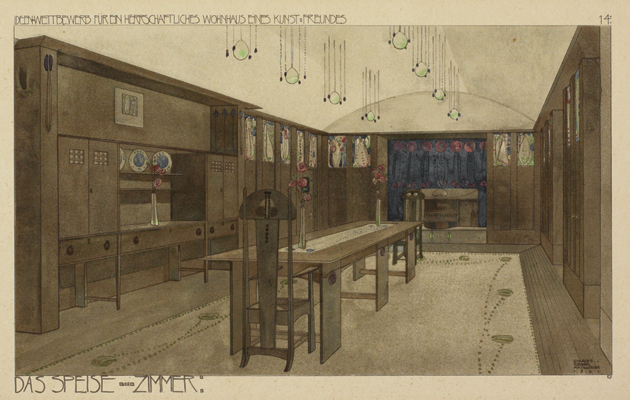Exhibition review: Mackintosh Architecture at RIBA, London
Gavin Stamp explores a show of Charles Rennie Mackintosh designs.

The career of the Glasgow born architect and designer Charles Rennie Mackintosh has long been the subject of mythmaking and exaggeration: Mackintosh the lone misunderstood genius, Mackintosh the true pioneer of Modernism. The truth, of course, is rather more complicated.
It’s too often forgotten that, for a quarter of a century, he was first a draughtsman to and subsequently a partner in the well-established Glasgow practice of Honeyman & Keppie. Making buildings is a collaborative effort and, within a firm, an individual may have made a greater or lesser contribution to a design. Some-times, a client would approach a particular partner, as Walter Blackie did when he asked Mackintosh to design his home at Helensburgh, The Hill House, and there is no doubt that he was the principal designer of certain public buildings, above all his masterpiece, the Glasgow School of Art. In other cases he may have made just a contribution to a particular job.
Nor were all the buildings he designed in his characteristic spare manner, enhanced with his individual, ‘New Art’ style of ornament and detail as he had to accede to the wishes of the client. It is now at last possible to know exactly what Mackintosh designed and when, thanks to a four-year research project organised by the Hunterian museum at the Uni-versity of Glasgow and led by Pamela Robertson. This has examined, among much else, the whole output of Honeyman, Keppie & Mackintosh (as the firm became in 1901) from 1888 until 1914.
The results are now on line at www.mackintosh-architecture.gla.ac.uk and the completion of this magnificent and valuable enterprise is being celebrated by an exhibition of original drawings, watercolours, film footage and models at the Royal Institute of British Architects (RIBA) in London. This is well worth visiting, even if many of the exhibits have been part of previous Mackintosh exhibitions.
The first was the memorial exhibition held in Glasgow in 1933, five years after the architect’s sad death in London and shortly after that of his wife, Margaret Mac-donald. A major exhibition was held in 1968 at the V&A, then in Edinburgh and Darmstadt but not in Glasgow, where anti-Toshie feeling lingered: the famous Ingram Street Tearooms were, shockingly and stupidly, dismantled by the Corporation as late as 1971. (Incidentally, 1968 the centenary of Mackintosh’s birth also saw the publication by Country Life of Robert Macleod’s fine revisionist biography, which undermined the Modernist inter-pretation of his work and explored his links with the English Arts-and-Crafts movement.)
Then, in 1990, an exhibition of Mackintosh’s architectural drawings was held at the Hunterian and, six years later, came the big show at the McLellan Galleries in Glasgow that subsequently travelled to the USA. Many of the drawings now on show in Portland Place may, therefore, seem like old friends. The famous pen perspectives, so often reproduced, are here the Glasgow Herald building, the Scotland Street School, Windyhill but it’s good to see them again, as Mackintosh was a real artist and one of the greatest of architect-ural draughtsmen. These exquisite drawings, some surprisingly large, are wonders: his careful but free lines delineated his vision while the drawings are enhanced by extraordinary skies and clouds, vibrant, fizzing trees, charming figures and characteristic Art Nouveau lettering.
There are also new models of Mackintosh’s unexecuted schemes here, both real projects and ideal designs never intended to be built (and which would have been best left as models, as the modern, mendacious realisation in Glasgow of his House for an Art Lover competition project confirms). But there are also new things.
Sign up for the Country Life Newsletter
Exquisite houses, the beauty of Nature, and how to get the most from your life, straight to your inbox.
Reflecting the nature of the Hunterian research project, designs by John Keppie are also exhibited as well as several obscure jobs by the firm small houses and house extensions in which Mackintosh had a hand. Then, there are some projects that do not conform to the conventional notion of a Mackintosh building. One is Auchinibert, a large, stone, rather Cotswoldy house at Killearn, for which he made some extraordinarily dense pen perspectives after having written to the client in 1905 that: ‘If you want a house in the Tudor or another phase of English architecture, I can provide you with my best services if you ask me to be your architect.’
There is one peculiarly poignant exhibit: a large cutaway model of the interior of the West Wing of the Glasgow School of Art, rising from the lecture hall in the basement through the library to the studio at the top next to the celebrated ‘Hen Run’. This wing, the second phase of the building, completed in 1909, was Mackintosh’s last large-scale work and the interior of the library arguably the finest thing he ever achieved. Its destruction by fire last year, a century after the unhappy and disillusioned architect left his native city for ever, was a catastrophe. We must hope it can be accurately re-created.
‘Mackintosh Architecture’ is at RIBA, 66, Portland Place, London W1, until May 23 (020–7307 3699; www.architecture.com)
-
 Some of the finest landscapes in the North of England with a 12-bedroom home attached
Some of the finest landscapes in the North of England with a 12-bedroom home attachedUpper House in Derbyshire shows why the Kinder landscape was worth fighting for.
By James Fisher
-
 The Great Gatsby, pugs and the Mitford sisters: Country Life Quiz of the Day, April 16, 2025
The Great Gatsby, pugs and the Mitford sisters: Country Life Quiz of the Day, April 16, 2025Wednesday's quiz tests your knowledge on literature, National Parks and weird body parts.
By Rosie Paterson